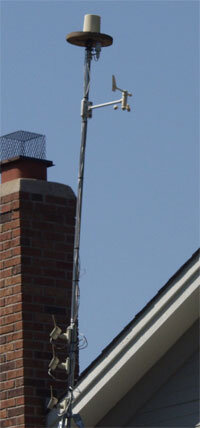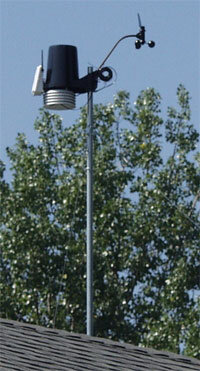Home Weather Station
I freely admit to being a weather geek. Six years ago, on a whim, I purchased an Oregon Scientific home weather station and installed it on my roof. This is a set of three wireless sensors (temperature/humidity, rain gauge, and anemometer [aka wind measuring gizmo]). The outside sensors transmit their measurements to an indoor base station where you can view the current conditions on a backlit LCD screen.
Aside from enabling meteorological geeking out ("Wow, I can't believe the dewpoint hit 78 degrees!"), this is largely useless. But it's cool, and I've really enjoyed having it. After some time, She Who Puts Up With Me grudgingly admitted that it's nice to be able to tell just how hot/cold/humid/windy/wet it is without having to go outside.
The old weather station. The three boxes mounted near the base of the pole are the wireless transmitters, one for each sensor. Note the tilt of the pole, and that the anemometer is below the peak of the roof.
Unfortunately, the Oregon Scientific weather station was pretty much a piece of junk. The weatherproof seals on the solar-powered transmitters weren't, and the anemometer failed completely within a few months of the time I installed it. The anemometer was never very accurate to begin with, thanks to my poor siting and installation, so I didn't mind too much.
A few weeks ago, the rain gauge failed, leaving just the temperature/humidity sensor. It was time to get a new weather station.
This time, I did some research. Knowing that I actually use the weather station on a daily basis, it was worth spending the time and money to get a good quality replacement and installing it properly.
I settled on the Davis Vantage Pro2 wireless weather station. It's more expensive than the Oregon Scientific model, but boasts a number of advantages: a higher quality sensor suite, all the sensors integrated into a single unit, a more precise rain gauge (measuring in increments of 0.01", rather than 1mm), better console displays, and--perhaps most importantly--consistently raving comments online about the company's support for its products.
The new weather station. All sensors are in a single unit with one solar-powered transmitter. Temperature/humidity sensor is inside the white unit below the rain gauge. Guy wires keep the unit stabilized even in high winds.
Installation
I mounted the old sensor suite on a TV antenna pole on the roof above our great room (see photo). There were a number of problems with this mounting: the anemometer was actually below the highest point on our roof, leading to errors with the wind speed and direction; the pole was not exactly vertical, so the rain gauge was probably slightly off; the temperature sensor was unshielded, and (despite my best efforts) was in the sun in the early mornings and late evenings. I also don't like climbing on the roof, so maintenance was a chore and rarely happened.
It made things worse that the Oregon Scientific setup had three separate sensors, which meant a lot of complexity in trying to get all three onto the same pole. In retrospect it might have made more sense to locate each sensor in a different place around the house, but I didn't think of that at the time.
In contrast, the new Davis unit has all the sensors in a single package (though the anemometer can be mounted separately), which makes it easy to attach to a pole. Rather than a rooftop mount, I decided to put the sensors on a 30-foot pole attached to the side of the house, with the base of the pole on a balcony. This is high enough to get the sensors several feet above the highest point on the roof.
My first attempt at mounting the sensors was with 1.25" galvanized pipe. This turned out to be much too heavy: close to 100 lbs of pole for a six pound package at the top. It was so heavy that we couldn't easily raise it within the limited confines of the balcony.
The next attempt was with PVC pipe, but while the PVC was much lighter (only a few pounds for the whole 30'), it was much too flexible: the pipe would bend completely double rather than lift the six pound sensor package off the ground. Even stabilized with guy wires, the pipe would likely buckle under any sort of load.
I considered going with a larger size PVC pipe (maybe 4" PVC for all but the top foot or so), but in the end, I settled on 1 3/8" fence pole. This is the stuff which is used for the horizontal rail on chain link fence, and it's relatively stiff (being made of galvanized steel), but not nearly as heavy as the pressure pipe. Even better, the sections slip together rather than being screwed or glued, meaning that the pole could be assembled as it went up rather than put together on the ground and hoisted in one piece.
I raised the pole by starting with the top section in a nearly vertical position, resting against a stepladder. I slid it up high enough to slip the next section in at the bottom (keep in mind I was on a balcony, so I only had to raise it a couple feet above the balcony floor to get the next section of pole on the bottom), then repeated until the pole was completely assembled and leaning against the roof of the house with the base sitting on the balcony.
Then, with She Who Puts Up With Me hanging onto a guy wire to keep it from toppling backwards, I gingerly raised the pole to vertical, slipped the base into a socket screwed to the balcony deck, and clamped it to the side of the house. The guy wires were anchored to the side of the house to keep the pole from swaying too much even in strong winds.
No going on the roof required.
Usage
So far the Davis weather station has been head and shoulders above the old Oregon Scientific model. In addition to the basic weather displays, it can graph any piece of data over the past 24 hours, 24 days, 24 months, or 24 years. The rain gauge is much faster and more accurate than the old one, and the console will display cute messages during certain conditions (for example, "It's raining cats and dogs!" during heavy rain).
There's also a set of diagnostic screens available, which are useful for troubleshooting the wireless connection (the Oregon Scientific weather station lacked any diagnostics at all), and a nice storm total feature in the rain gauge which tracks the cumulative rainfall for any rain event. I only have a couple of minor quibbles: the console won't calculate the indoor dewpoint (which is sometimes nice to know), and leaving the backlight on for too long will raise the reported indoor temperature since the indoor sensor is located inside the console (one nice feature of the Oregon Scientific unit was the remote sensor for indoor temperature, so I could place that where it was most useful).
I've ordered the hardware and software for capturing the data on my home computer, which will increase the geek-out factor even more.
So color me a satisfied customer. This is one of the better toys out there.

